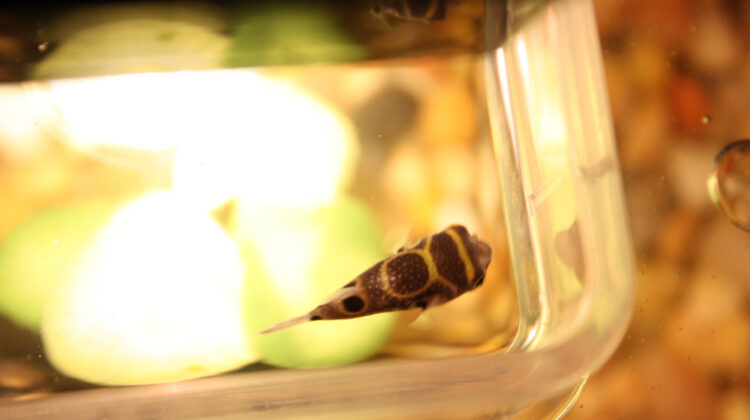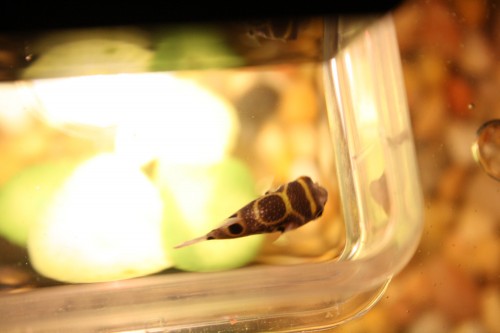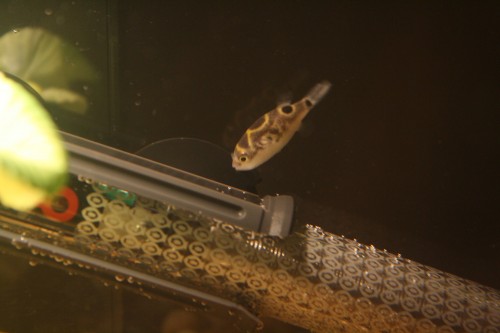
A trip to my local fish store (LFS) last week turned into an adventure in setting up my first brackish aquarium. They had just received a shipment of figure 8 and green spotted puffers. How could I resist? This is how I prepared the brackish aquarium for the new puffer.
Setting up a brackish tank
Figure 8 and green spotted puffers start spend a great deal of their natural lives in freshwater and many fish stores sell them as a freshwater fish. However, their natural environment is where the rivers meet the ocean so they do best in a brackish aquarium.
Brackish tanks are saltwater tanks with less salt than your typical reef or marine aquarium. Reef and Marine aquariums are kept at a salinity of 1.024 – 1.026, whereas brackish tanks are kept at around 1.005 – 1.008.
UPDATE: reddit.com user, 4rch, had a great tip for people who have existing freshwater tanks that want to convert to brackish. You should make the conversion slowly so that you don’t kill the bacteria. This is done through slowly increasing the salinity through water changes. After a little searching around it seems a good rule of thumb is to increase specific gravity (salinity) by 0.002 every week through water changes until you reach the brackish range of 1.005 – 1.008
To setup a brackish tank you should use the same salt mix that is used to setup a saltwater tank. I used Instant Ocean marine salt mix for my setup. You will also need a hydrometer to test the salinity of your tank to make sure you have the mix right.
Puffers are a messy fish and so the rule of thumb of one gallon per inch of fish doesn’t apply to them. The ideal setup is five gallons per inch of fish but that is just the bare minimum. Ideally you want the largest tank you can afford and/or convince your significant other to let you have. Here are some quick stats about these fish to help in deciding on the size of tank you should purchase:
Figure 8 Puffer
Size sold: .5 in. – 1.5 in.
Max Size: 3 in.
Max Age: 15+ years
Minimum Tank Size: 15 gallon
Best Tank Size: 30+ gallons
Green Spotted Puffer
Size sold: 1 in. – 2 in.
Max Size: 6 in.
Max Age: 15+ years
Minimum Tank Size: 30 gallons
Best Tank Size: 90+ gallons
Once your water is prepared, you still have to cycle the tank as you would with any aquarium.
Cycling a brackish tank
Cycling the tank works the same as both it does in both freshwater and saltwater aquariums. You need to allow the bacteria to get established in your tank before introducing the new fish. Typically this process can take about a week.
If you don’t know how to cycle a new aquarium you should read this excellent article on how to fully cycle your tank without using fish: Fishless Tank Cycling
Including proper tank decorations for a puffer
Puffers are highly active fish, but like all fish they are prone to stress related illness, so they need to feel secure in their new environment. The best environment is a sand or gravel substrate with lots of live or plastic plants for them to hide in. It would also be a good idea to give them some sort of cave that they can hide in.
All species of puffer are aggressive even to their own species. It is a good idea to have lots of hiding places if you plan on having more than one in the same tank. Of course individual behavior varies greatly so you won’t know how tolerant an individual puffer will be with other tank mates until you get them.
Acclimating your new Puffer
My LFS had the puffers in freshwater aquariums with just a mild amount of aquarium salt in them. Since my setup was a fully brackish tank I had to slowly acclimate the puffer to the new tank through drip acclimation.
It took about an hour to acclimate the new puffer to the brackish water. Once acclimated I put him in the tank and he immediately began exploring the tank. Puffers are highly active and curious fish. Here he is checking out the heater in his new tank.
Feeding the new Puffer
Puffers mouths have teeth that never stop growing. They need crunchy food, like snails, shrimp, mussles and crabs, to wear down their teeth or their teeth may grow so much that they are unable to eat. If you notice your puffer having trouble eating you can trim their teeth using the process seen is this video:
That’s what I have learned so far about keeping a figure 8 or green spotted puffer fish. If I missed anything or got anything wrong, please let me know in the comments below and I will update this post.










Nice article.
I am new to keeping puffers. I have a 30g tank that was setup two weeks ago. I has fully cycled and ready for my puffers. The local fish store has 2 leopard spotted puffers and 2 figure 8 puffers…
Is the leopard spotted just another name for a green spotted puffer, or are they a similar to the figure 8? I’m thinking about getting one of each, but if the leopard will reach 6” in size, then this might not work for the 30g tank!
The tank has lots of drift wood, and hiding places, so reducing the sight lines should not be problem for two of more fish.
What do you feed your pufffers? The local fish store wasn’t’ very knowledgeable when it came to that..and suggested I give them normal tropical fish flakes… I’m pretty sure that won’t work.
What would you recommend?
Hello,
I noticed there was no reply to your comment.
I hope you have found your answer elsewhere but I’ll tell you what I feed my GSP.
He likes Shrimp pellets (bottom feeder food) I just tried turtle food and he is tearin’ it up! Puff likes fish flake just fine, his favorite though are snails.
Go to petco/smart any local pet store and ask them for the small snails in their tanks. They will gladly give you as many as you want for free. Reason being is that they reproduce rapidly. Instead of making weekly trips to the store- I eventually put a few in a different fish tank and BAM two weeks later tons of snails to feed to Puff. They really help his ‘beak’ whihc is good because I hope I never have to trim it!!
Good luck with your GSP,
Cailin
I have two Green Spotted Puffers, I feed them (thawed) frozen brine shrimp and bloodworms mixed together. plus every once in a while I feed them a shrimp (bought from local meat market) and mealworms. You really don’t want to feed them anything that floats on the top of the water, because the suck in air and its not good for them to do that.
Thank you for your comment. You are right that it is best not to feed them anything that floats. It is also a good idea to give them a snail snack. The hard shell of the snails helps to keep their beak trimmed down. I used to go to the LFS and they would give me the snails for free from their planted tanks.
I advice against keeping spotted puffers and figure eight puffers together.
I have three figure eight puffers and had one green spotted puffer. The figure eights ate a big part of the green spotted puffer and i had to put it down.
From what I read, spotted puffers grow to be a lot bigger and more aggressive than figure eights.
I agree with you on keeping gsp and fep in the same tank. I’ve tried it before myself and it was not good. I lost both my figure eight puffers, and the green spotted puffers became very mean, I let my ex keep them. I now have two baby figure puffers, a albino shark, a algae eater and 4 glo fish they all get along happly. Soon I will have to move my babies(f8p) to there new home (brackish) when it gets done cycling. Still trying to figure out what live plants are safe to put in with them. I know the plastic plants aren’t good, causing injuries to the puffers.
Great article and thankyou for the write up. I was wondering as i just set my new tank up for figure 8 puffers which i get in 10-14 days. What temp should i set the? Its a 100ltre tank. Also i brought 2kg of marine salt and the guy worked out about 138g of salt but i think his decimal place was a bit out but he did say to check it, any advice on the above would be awesome :-)